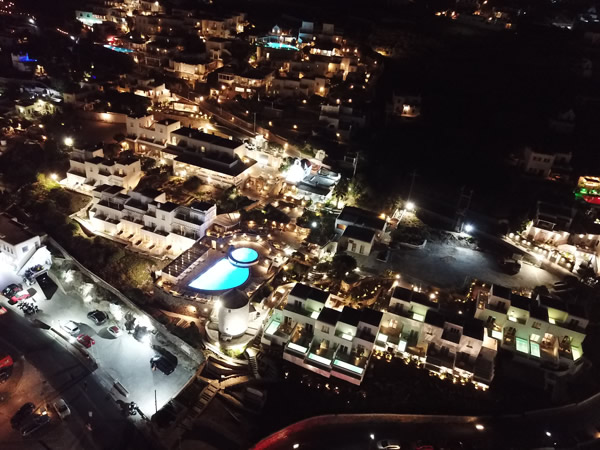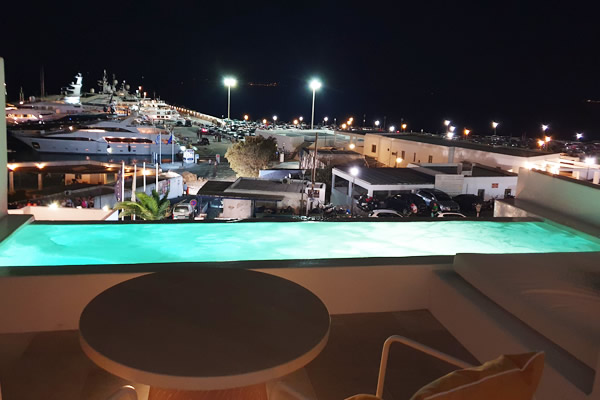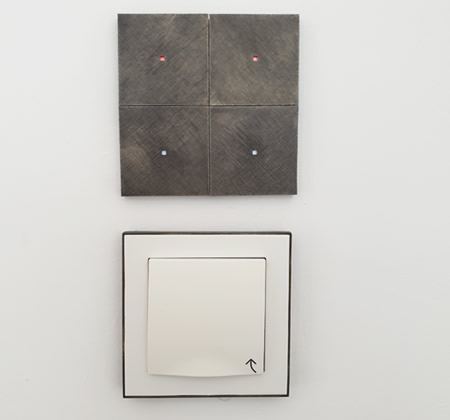 By Nick Gliatis, GDS Digital Systems.
By Nick Gliatis, GDS Digital Systems.
Comprising 90 rooms, Porto Mykonos is a luxury hotel located at the famous and bustling port of Mykonos Town on the Greek island of Mykonos. This is where all the action happens, both by day and by night.
The hotel was to undergo major renovations, including expansion, so a talented interior designer/architect was hired to draw up the plans, and GDS Digital Systems was approached to look after the electrical planning and the BMS system.

The brief
The project was to be carried out in two phases. In the initial planning phase, it was calculated that the existing electrical supply had to be increased by 125KVA. Unfortunately the power company was unable to deliver that additional power in one single supply, so it decided to add a second supply. The trouble was that the new supply was to be restricted to just 40KVA.
Given that the cost of a luxury room at Porto Mykonos is EUR2000 per night, the damage to the hotel’s reputation, were it not fully-functioning, would be enormous. We were, however, confident of KNX coming to the rescue, so we decided to accept the challenge of operating the hotel with 85KVAs missing.
The solution
GDS developed an intelligent room occupation device and a power demand monitoring system. The former detects room occupation so accurately that even if a guest hides under the bed, the system knows that the room is in use. It is responsible for switching the lights and air-conditioning (AC) off when the clients are absent and return the room to the exact same state upon their return.
The device monitors the room power consumption and calculates the heating/cooling demand. It is parameterised with the room loads, communicates with the central power management system and sends the calculated energy demand for the next hour. The upper and lower limits of the requested temperature are restricted to reasonable values, although the thermostat itself is not restricted. The users may select any temperature between 18 – 30C but the actual room temperature will never drop bellow 23C or climb above 26C.
Lowering the power demand
The smart system’s function is to prolong the AC system response. The challenge is not in controlling the energy consumption, but the power demand. Since Energy = Power x Time, the same result can be achieved over a longer period of time. The device dynamically calculates the energy losses and the room’s thermal capacity based on the room orientation, current shading, time of day, environmental measurements and some constant factors provided by the architect, such as wall thermal resistances and the U values of Windows.

AC operation with opened windows and doors is not allowed. So, the dynamic power demand calculation receives, as input, the requested temperature, actual temperature, room shading and the parameters described above. It also calculates a correction factor that depends upon the temperature change rate (dT/dt). The system ‘tricks’ the inverter AC units by sending them a calculated setpoint depending on the calculated power required to achieve the user set point, the available power and the centrally-calculated total hotel AC power demand, thus decreasing the slope angle of the heating/cooling curve at the given time. This reduces the requested power.
This ‘cheat’ enables the AC unit logic to operate its compressor at lower power, which means that the room temperature changes at a slower rate, that is, it achieves the goal in more time. Some mathematics and a good Texas Instruments CPU were all that was required.
Taking time to get the temperature right
As an example, if the room temperature in cooling mode is 27C and the user demands 23C, the system will send 26 to the AC unit, then 25 then 24 and then 23. The change is calculated based on the rule that the room must not be left without minimal cooling for more than an hour. When the central system detects that the total power demand will be higher than the available power, it schedules the AC service in a round robin after it sorts the rooms by the calculation of:
Requested temperature minus actual temperature
That is, the room with the largest difference between the requested and the actual temperature takes priority over the others.
Also, when an AC is switched ON by the user but OFF by the system, the AC fan is kept on, but the setpoint sent to the AC unit is 30C for cooling. This keeps the fan running but saves 95% of the power requested by this AC unit and the user does not immediately detect the change because the fan circulates the already-cool air.
Other KNX control features
All of the other features in the rooms are those one can typically expect from a good KNX installation. There are dimmers everywhere, visualisation and a room operation via tablet, and KNX-based room access control with a KNX card reader and KNX card holder.

Each room is equipped nominally with 18 lighting channels and 4 rollers and curtains. Scenes are user adjustable, although the room operation is kept simple based only on scenes and scene level control.

The system is also responsible for domestic hot water production and distribution, fault monitoring and providing client presence data to the reception and to room service. It also controls the surrounding area lighting. The room can be controlled remotely by reception and technical support.
Everything in the room is custom designed in detail by the architect, including the luminaries, the furniture and also the push buttons. The room number is incorporated on a mailbox along with the access control reader. For the room switches, a special order was given to Tense that resulted in an amazing jewelled switch. On either side of the beds are specially-designed switches based on push buttons with binary inputs behind.

Conclusion
The KNX installation in this hotel provides all of the control, automation and monitoring features expected of a high-end establishment. Its stand out capability however, is an impressive reduction in power demand without impacting on guests’ comfort.
The hotel has been operating successfully since 1 July 2019, and during the hot Greek summer days, the KNX power-reducing solution has proven reliable. A positive result is that the actual energy consumption in comparison to last year is 25% less, even though 18 additional rooms are now in use. This serves as an encouraging example to other businesses or individuals that wish to reduce their carbon footprint.
Equipment list
Tense switches.
ABB and Siemens dimmers, switch actuators and blind actuators.
ABB push button interfaces.
Ekinex thermostats and push buttons.
Intesis AC interfaces.
ABB Weather station and shade calculation.
ABB access control.
Apricum power supplies, IP routers and line couplers.
GDS specially-developed room occupation detection and power demand calculation.
Nick Gliatis is the managing director of GDS Digital Systems Ltd, a KNX Member company developing KNX devices, as well as managing demanding automation projects where high levels of know-how and a strong theoretical background are required.












